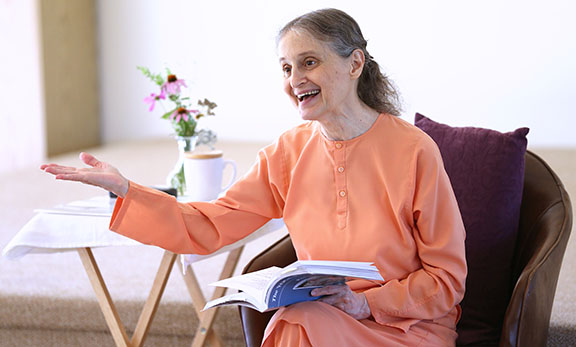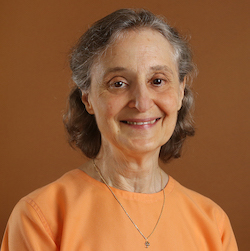 Our whole experience of life is based on the stories we tell ourselves about what unfolds. Swami Vivekananda describes it like an oyster making a pearl. A parasite gets inside the shell, and then the oyster reacts to the irritation by producing enamel around it, which we then call a pearl. The actual universe is like the parasite; all that we ever know are the pearls created by our own minds. In the Yoga Sutras, Sri Patanjali describes these reactions or activities of the mind as vrittis. Our known universe consists of these vrittis, the thought-waves of the mind.
Our whole experience of life is based on the stories we tell ourselves about what unfolds. Swami Vivekananda describes it like an oyster making a pearl. A parasite gets inside the shell, and then the oyster reacts to the irritation by producing enamel around it, which we then call a pearl. The actual universe is like the parasite; all that we ever know are the pearls created by our own minds. In the Yoga Sutras, Sri Patanjali describes these reactions or activities of the mind as vrittis. Our known universe consists of these vrittis, the thought-waves of the mind.
Like the ebb and flow of the ocean, like waves breaking upon the shore, the world as we perceive it is thus subject to constant change. Change entails releasing the familiar and encountering the unknown. It is fraught with uncertainty, makes us aware of our vulnerability and evokes feelings of insecurity. The fragility and unpredictability of life gives rise to suffering.
The goal of Yoga is to calm the waves of the mind so we can see to its depths and experience the ground of our being—the peace, balance and stability of our own true nature. Stilling the ocean is no small task, so Patanjali provides us with a multi-faceted analysis and approach.
In Book 1, Patanjali describes the vrittis. In Book 2, he examines the underlying mechanisms that cause them. These are the kleshas, the basic afflictions of the mind. Primary among them, and the root cause of all suffering, is ignorance of our true nature, or avidya. We forget our true nature, the divine Spirit within us that is ever peaceful and joyful, which Patanjali refers to as the Purusha or atman. And, if that weren’t bad enough, we think we are something else. That’s when the next klesha, egoism, or asmita, comes in. We identify with what is closest to us, the mind and the body, and think that’s who we are. This is problematic at the outset because, unlike our true nature, the mind and body are constantly changing. So instead of having a reliable lens with which to navigate through life, it’s as if we have a kaleidoscopic one. Then, we become attached to what we find pleasurable and averse to all that is painful (raga and dvesa). We find ourselves continually buffeted by the shifting currents, known as the dualities in life: pleasure-pain, loss-gain, praise-blame, hot-cold, success-failure, etc. In the midst of all these comings and goings, triumphs and tragedies, we cling to bodily life because we think that defines our existence. This is the final klesha (abhinivesha).
The kleshas are the root cause of dis-ease in life. When there is an underlying ailment, there are usually observable symptoms that appear. These are listed in Book 1 as the basic obstacles commonly encountered on the spiritual path: disease, dullness, doubt, carelessness, laziness, sensuality, false perception, failure to reach firm ground and slipping from ground gained. Accompaniments to the obstacles include: distress, despair, trembling of the body and disturbed breathing. This sounds like a medical analysis, and according to tradition, Patanjali is believed to have authored not only the Yoga Sutras, but a medical text as well. Like an expert physician, he identifies the disease, describes the symptoms, determines that it is curable and then prescribes various remedies. In one of the most life-affirming, hope-filled sutras, Patanjali joyfully proclaims that, “Pain that has not yet come is avoidable.”
In prescribing the remedies, we can clearly see the broadmindedness, compassion and keen insight that are woven throughout the Sutras. Patanjali always recognizes the varied temperaments, beliefs and capacities of his audience and never tries to force everyone into one mould or approach. A striking example of this eclectic wisdom is seen in Chapter 1, sutra 39. After a series of sutras that describe specific objects for meditation, he concludes by saying: “Or by meditating on anything that one chooses that is elevating.” Along with specific guidance, he gives his students the freedom to choose what they feel will work best for them. The same is true when it comes to overcoming the obstacles.
The main thrust of the Yoga Sutras is attaining mastery over the mind through the practice of meditation, but Patanjali offers another option as well. Initially, he states that, in order to accomplish chitta vritti nirodhah, we need practice and non-attachment (1.12), which means discipline and freedom from all craving. This is a daunting undertaking, one that might easily discourage some aspirants. Shortly thereafter, however, in a seminal sutra (1.23), he suddenly announces: “Or [samadhi is attained] by devotion with total dedication to God.” This is all the more remarkable when one considers that this is a radical departure from the Sankhya metaphysics upon which the Yoga Sutras is based, which contains no such concept of God.
Isvara pranidhana, which translates as devotion, dedication and surrender to God, is the only practice recommended to treat both levels of obstacles: the underlying afflictions in Chapter 2 and the symptoms in Chapter 1. In fact, as sutra 23 in Chapter 1, it is the first specific practice given in the Yoga Sutras to attain the goal. It reappears in Chapter 2, sutra 2, right before the kleshas are explored, as one of the means to minimize the afflictions and attain samadhi. And it surfaces yet again, as one of the precepts of niyama (the five observances), when the eight limbs of Ashtanga Yoga are presented. It stands out as being the only precept that yields samadhi as a result. The placement and prominence of this concept has made me wonder at times if Patanjali might not have been a “closet bhakta.” It seems he may have regarded the devotional path as a direct and possibly easier approach, if one possessed the proper faith and temperament.
If you are truly devoted, you have found an effective way to control your thoughts, as the following story illustrates: A profligate actor once visited Sri Ramakrishna and asked to be his disciple. After professing his love for the saint, the actor said he was addicted to cigarettes and alcohol and frequented prostitutes, as well, and did not wish to relinquish any of his bad habits. Sri Ramakrishna accepted him as his disciple with one qualification: Every time he was about to engage in one of those habits, he would have to offer it first to his Guru.
The actor departed happily, having gotten his wish. That night, after a performance, he sat down and lit up a cigarette. He raised it to his lips and pronounced: “In the name of Sri Ramakrishna.” He immediately stopped short, thinking to himself, “How can I smoke in his name? He would never do such a thing.” So, he put out it out. He proceeded to pour himself a glass of whiskey, and the same thing ensued. He went to visit a lady friend and found himself in a similar predicament. Because he truly adored his Guru and saw the divine in him, he could no longer do those things in his Guru’s name, and so all the weaknesses were readily overcome.
In Chapter 1, Patanjali states that by repeating God’s name, all the obstacles will disappear and, simultaneously, knowledge of the inner Self will dawn. Recognizing that not everyone has a devotional nature, he follows with a sutra that widens the scope: “The practice of concentration on a single object is the best way to prevent the obstacles and their accompaniments.” Putting the two together, one can conclude that if your heart doesn’t naturally flow toward God, you can train your mind to focus on an object of your choice. Either way, success will be yours.
In dealing with the afflictions in Chapter 2, he offers a three-fold approach known as Kriya Yoga to help overcome them. This consists of tapas, svadhyaya and Isvara pranidhana. In so doing, he addresses the three main aspects of an individual: will, intellect and emotion. Tapas can be understood as accepting pain as help for purification. It enjoins us to use garner our will when problems arise and accept them as a means to purge our past karma. Literally it means, “to burn,” and just like gold is purified when placed in the fire, so, too, through the fire of tapas, all the dross in our bodies and minds is eliminated, so the divine light within can shine forth without any obstruction.
Svadhyaya can be understood as spiritual study—outwardly of sacred texts, and inwardly through reflection and the recitation of mantra. It engages the intellect to gain guidance and inspiration and helps develop and refine its capacity for discernment. Ultimately, when true discernment is achieved, we are able to discriminate between the unreal and the Real. Then ignorance, the root affliction and cause of all the other problems in life, is dispelled, and we are totally liberated.
With Isvara pranidhana, we go through life with an expanded vision. Emotion is transmuted into devotion, as we realize that we, along with everyone and everything, are being consciously and lovingly cared for every moment in the best way possible. As the Hindu scriptures declare, not even an atom can move without the will of God. If that faith and surrender is there, nothing will ever disturb your peace. Obstacles become opportunities—adversities, blessing in disguise. The mind will retain its undisturbed calmness, and we will rest in our true divine nature always.
About the Author:
 Swami Karunananda is a senior disciple of Sri Swami Satchidananda. In 1975, she was ordained as a monk into the Holy Order of Sannyas. She has had over 40 years experience teaching all aspects of Yoga and specializes now in workshops, retreats, and teacher training programs that focus on the science of meditation, the philosophy of Yoga, personal transformation, and Yoga breathing techniques for better health and wellbeing. She developed, and for 25 years has taught, the Integral Yoga Teacher Training programs in Raja Yoga and in Meditation.
Swami Karunananda is a senior disciple of Sri Swami Satchidananda. In 1975, she was ordained as a monk into the Holy Order of Sannyas. She has had over 40 years experience teaching all aspects of Yoga and specializes now in workshops, retreats, and teacher training programs that focus on the science of meditation, the philosophy of Yoga, personal transformation, and Yoga breathing techniques for better health and wellbeing. She developed, and for 25 years has taught, the Integral Yoga Teacher Training programs in Raja Yoga and in Meditation.
Swami Karunananda served as president of Satchidananda Ashram–Yogaville in Virginia and in California, as well as director of the Integral Yoga Institutes in San Francisco and in Santa Barbara. She currently serves on the Board of Trustees, and as the chairperson of the Spiritual Life Board at Satchidananda Ashram–Yogaville, Virginia.
Interested in fostering interfaith understanding and harmony, she is featured in the interfaith documentary entitled, With One Voice. She also compiled and edited the Lotus Prayer Book, a collection of prayers from various faith traditions, and Enlightening Tales as told by Sri Swami Satchidananda. She served as contributing editor for The Breath of Life: Integral Yoga Pranayama, as well as a senior writer for the Integral Yoga Magazine. In her book, Awakening: Aspiration to Realization Through Integral Yoga, she describes the spiritual path and provides guidance for the journey.

